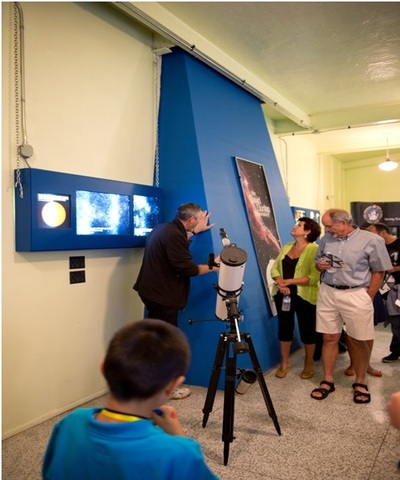
I used to look at the sky, thinking about how astronauts ever reached the atmosphere. I used to think of it as if it’s another world. I was far away. Then, the little device called ‘binoculars’ came into my hand when I was six. In the day, the sun was prominent behind my blooming cherry tree. At night, stars remain silent, but shimmer across the deep sky. I became ardent to get one step closer with a telescope set. Finally, I got the chance to visit the other planets through the eyes of the David Dunlap Observatory (DDO).
On a July evening, my family car was parked up in a forest environment of Richmond Hill. Staring through the trees, the top of a pure white dome was coated with an amber shine by a beautiful sunset. This building is The Observatory, whose sidewalk leads directly north. The DDO was proposed by Clarence. A. Chant, the father of astronomy, and was established in the 1930s by David Dunlap. DDO includes the largest telescope in Canada. In 2013 it celebrated the 16,000'th visitor since 2008 – 2009.
You definitely don’t have to be an astrologist to enjoy the view through the telescopes of the Royal Astronomical Society of Canada, Toronto Centre. Since 2009, DDO started educational programs for kids. I was prepared for the family talk tonight, and can’t wait to be old enough for the ‘Star Talk’ program next year. The ‘Star Talk’ program offers awesome topics on astronomy, space science and sometimes, science fiction. The ‘Family Nights’ program is a great introduction to the night sky for the younger guests. Unlike ‘Star Talk,' the ‘Family Nights’ program accepts any child in a range between 8 and 17 years old.
At 9:00pm, The Observatory door opened. Mr. Ed Hitchcock, our program operator, welcomed us to the program with a big smile. Before Ed brought us to the second storey, he showed us a blue concrete piece on the wall. The structure isn’t a normal wall. It’s actually isolated from the building with a layer of rubber plastic, which goes up to the second floor and two storeys underground, anchored to the bedrock. “Now, no matter how you jump, the vibration doesn’t carry over to the structure. So that keeps the telescope super vibration- proof,” Ed said. Once we stepped onto the second floor, we came to a massive telescope pointing at the sky like a canon. The telescope was only 2 inches larger than the one in Vancouver BC, and was titled ‘Largest’ in Canada.
“It was built in England, disassembled, brought to New Castle, reassembled, tested if it worked, disassembled, brought to Richmond Hill, and then permanently built,” explained Ed. When you think of telescopes, you will most likely think of glass lens, but this telescope uses mirrors. Ed told us, “We’re actually looking for something to gather faint light from other objects, rather than reflections. A mirror can focus the light the same way as a lens can, but the advantage is that you can bounce light off the front surface without blocking the path of light.” In the DDO, the mirrors are cleaned, and recoated with a fresh thin layer of aluminum every other year, which rustproofs and shatter-proofs the delicate glass. The telescope was built in the 1930s, and there wasn’t enough technology for the telescope to be automated and computerized. However, even with the lack of technology, DDO has still found and done research on the first black hole.
After we visited the telescope, a couple of the volunteers directed us to a room on the second floor of The Administration Building. It’s a room with cushions scattered on the floor and the lights turned off. A large picture that showed the DDO at night was projected onto the wall. It gave me the sensation that I was lying down on the grass while watching the sky.
“Do you know which star is always visible each and every night throughout the year, and do you know why?” Our speaker, Rob, started his presentation with an interesting question. “Yes, Polaris, the North Star. It appears unmoving in the sky because it’s positioned close to the line of Earth's axis projected into the space. The way people used to find home was to follow the North Star.” Rob also talked about planets, galaxies, constellations, stars and their life cycles. Specifically, scientists proved the first black hole by observing a star named HIP98298. A spacecraft named Kepler was mentioned by Rob too. Kepler was launched in 2009, on the mission to find exoplanets similar to the Earth. In the end, Rob introduced us to a useful website called Stellarium to check out other stars and planets.
David Dunlap Observatory is not only a cool building where scientists do research, but also a place with some of the most fascinating educational programs of which kids benefit. This year I can enjoy all of these epic sights in an open area. If the city council decides to build nearby, they can simply be blocking a blinding view of the sprinkling stars. I hope the DDO doesn’t have a shortage on money. When I’m 11, I will be allowed to participate in the ‘Star Talk’, with more information, more perfection, and more fun.




 RSS Feed
RSS Feed